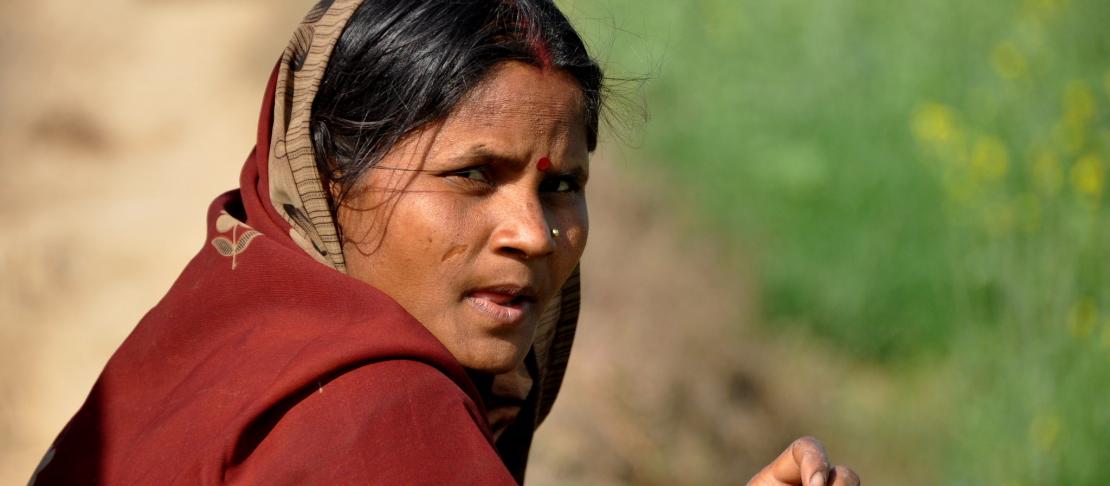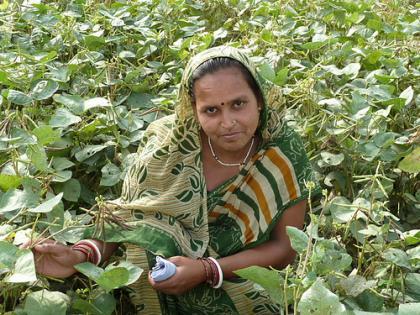Changing farming practices in South Asia for a food secure future

by S. N. Sharma and Mritunjaya Kumar
The CGIAR Research Program on Climate Change, Agriculture and Food Security (CCAFS) South Asia office, in partnership with IFFCO Foundation, India, recently started piloting climate smart agriculture technologies in three villages of Vaishali district, Bihar, India.
Given the pilot got underway less than a year ago progress is impressive with solid impacts already demonstrated in the ground and importantly trust of the farmers is evident.
One of the several interventions of climate smart agriculture, has been mungbean inclusion in the cropping pattern. Mungbean has shown to outperform the traditional farmers practice in the area.
Mungbean, a prominent short duration crop of the summer season, has been cultivated by the farmers since ages. However, farmers treat this as a crop of minor importance because it has a relatively poor yield potential. Farmers never realized that with improved cultivation practices including the use of improved variety would be a lucrative source of livelihoods.
As a matter of fact, farmers generally used to broadcast seeds and provide a supplementary irrigation with little or no intercultural operations during the life cycle of the crop. Many of the farmers have tendency to keep land fallow for 65-70 days after the harvest of rabi crops and before the sowing of kharif crops. As a result of which cropping intensity was lower and farmers had lower farm income.
Realizing the potency of good quality seeds of improved variety of mungbean to exploit the fallow period and increase soil fertility, farmers were mobilized to pilot with Pusa Visal variety of mungbean. Limited quantity of good quality seeds were distributed to 200 farmers and instructed to sow in the line at a spacing of 30 cm soon harvesting of rabi crops. A fertilizer dose of 20-30 kg N/ha and 30-50 kg P2O5/ha was applied at the time of sowing. The crop was irrigated 2-3 times at branching, pre-flowing and pod filling stages.

The yield obtained in these trials ranged from 0.80-1.70 t/ha as against 0.30 to 0.80 t/ha under farmers’ practice. The average yield of Pusa Vishal variety was 1.24 t/ha (SD= 0.23, n= 109) while that of local varieties under farmers’ practices in the last year was 0.56 t/ha (SD= 0.12, n=109), more than two fold increment over farmers’ practices. Some of the farmers who used this variety along with improved agronomic management expressed that they got a drastically higher yield (4-5 folds) this year.
Now farmers consider mungbean a crop that handles risk and the crop that helps diversify farm production. According to those farmers, previously they had maximum of 3 pickings and this year they took minimum of 4 pickings. Besides grain yields, farmers are advised to incorporate residue in the soil to enrich edaphic environment.
A farmers’ field day was organized in the first week of June to showcase the performance of mungbean to the government officials and non-participating farmers. Scientists from research institutions and government officials from Vaishali district along with surrounding farmers,
CCAFS visitors and IFFCO Foundation technical persons attended farmers’ field day and observed the performance of the crop in the field.
Government officials commended the CCAFS activities in the climate smart villages and assured that government will help farmers provide training on vegetable production, pest management and off-farm activities.
“Initially it consumed more labor while following line sowing method and performing intercultural operations. We had a doubt that we may not get good yield to justify the use of inputs. But now our doubts have gone away and we all are extremely happy with the bumper production (almost 2-4 times more grain yield than what we harvested last year)”, said Mila Debi, a progressive female farmer from Bhattadashi village, Vaishali. She also said that non-participating farmers are now putting a heavy pressure on her demanding seeds of this variety so that they could plant in the next year.
Jagadish Singh, a farmer from Mukundapur village said “we were doing dead agriculture and now we really see the results for the first time”. Farmers expressed that improved variety of mungbean could help them adapt to climate variability because they could harvest comparable yield with less irrigation or even under drought situation.
Inclusion of this crop in farming also enhances sustainable intensification of the system.
Watch photos from the farmers' field day trip:
The blog post was written by S N Sharma, Emeritus Professor and Project Leader of IFFCO Foundation and Mritunjaya Kumar, Field Coordinator at Vaishali district, Bihar, India. To get more updates on our research in South Asia, follow us on Facebook and Twitter @Cgiarclimate.